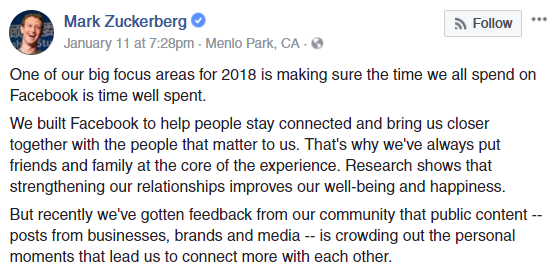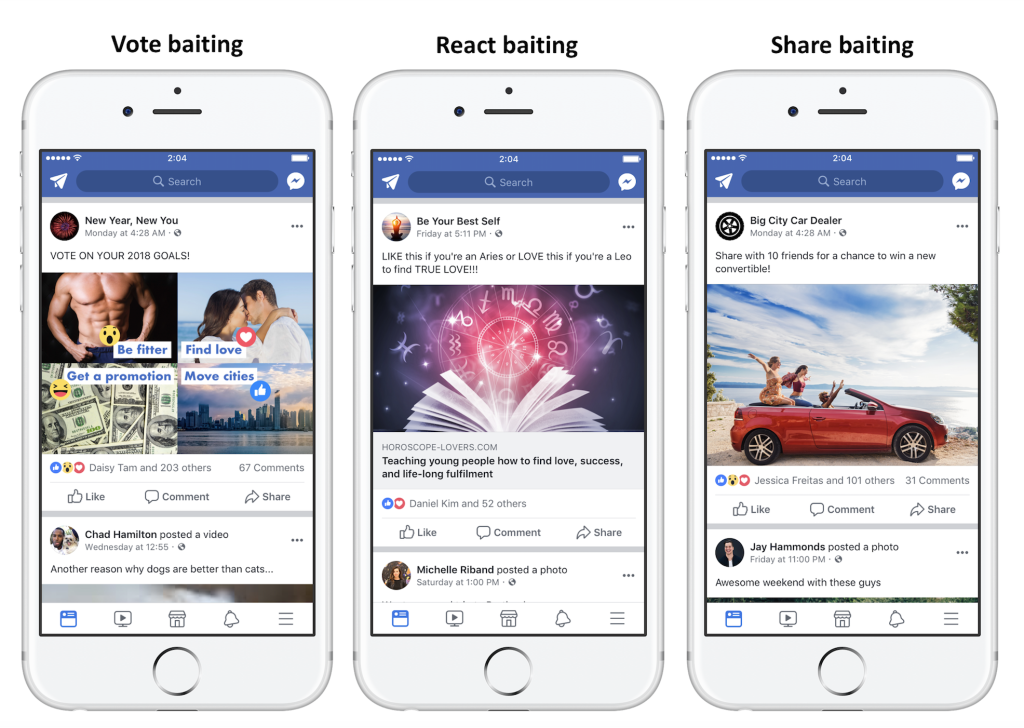How The 2018 Facebook News Feed Algorithm Update Will Impact Your Brand
Changes to the Facebook News Feed Algorithm in 2018 will impact your brand's page posts. Find out how you should adapt your content strategy to end up a winner.
Freaking out over the 2018 Facebook update?
Although some marketers might make it sound as if the world is ending, there’s no need to panic quite yet.
Sure, even the smallest changes to Facebook’s algorithm might seem like cause for alarm.
But when we look at the 2018 update under a microscope, we can break down how the new algorithm will impact brands and what they need to do to adapt.
The 2018 Facebook News Feed Update (in Plain English)
For starters, let’s pick apart this new update in plain English.
Ol’ Zuckerberg kicked off 2018 with the announcement that Facebook would be putting “friends and family” first.

Later in the post came the proverbial bombshell that sent marketers scrambling.
Facebook explicitly announced that they’re “limiting” public content from brands and businesses, looking to hold them to a higher standard.
In Zuckerberg’s own words, brand content should encourage “meaningful interactions between people.”

The “kitchen table” definition of the 2018 update? Facebook is prioritizing comments and conversation over shameless promotion. Meanwhile, promoted content deemed too “salesy” is being demoted.
The purpose of this update (according to Facebook) isn’t to drop the hammer on brands and punish marketers.
Instead, Zuckerberg and company are looking to stop the marketing spam in the feeds of unsuspecting users.
On the flip side, brands are more than ever being encouraged to “pay to play” when it comes to promotional content. This evidenced by the fact that Facebook keeps rolling out new ad types such as dynamic ads, making their advertising platform look more like Google by the day.
Oh, and the 2018 Facebook update looks to put a stop to engagement bait and other “spammy” tactics marketers have traditionally used to game the algorithm.

At a glance, the move makes sense from Facebook’s perspective. Nobody wants their feeds flooded with promotional garbage as Facebook is looking to put its users first.
Still, these changes signal a sobering fact – brands will have a more difficult time showing up in the feeds of their fans and followers.
That is, unless they make some key changes to how they push their content.
So what are brands supposed to do in response?
How Brands Can Survive Facebook’s New Algorithm
It’s important to remember that Facebook’s algorithm isn’t some sort of sorcery.

Between Facebook’s own best practices and reading between the lines, brands can still survive (and hey, maybe even thrive!) in the face of these changes.
The key is finding ways to encourage interactions on your posts minus any sort of begging or sales pitch. While this may seem like an uphill battle, it’s far from impossible as evidenced by a number of prominent Aussie brands.
Ask More Questions
If you want something, sometimes it’s best just to ask for it.
Seriously.
Although asking explicitly for comments or shares has been labeled a no-no by the update, posing questions to your follower is a spam-free way to encourage a response.
Check out this example from Australia.com as they tack a question onto a post that otherwise might not have seen as much love in the comment section. Presenting the post as a question likewise encourages people to share it around and compare their answers.
And here’s another quick example from Luna Park:
Coupling your posts with a question is a no-brainer and a smart alternative to simply dropping a link and walking away.
Encourage Engagement Without Bait
Since Facebook has outright outlawed “bait” posts and has generally been on the warpath against clickbait, brands have to tread lightly to avoid being labeled as a spam.
And while you’re not going to burst into flames for posting a tag-a-mate post, it’s always a good idea to have some backup ideas in the bank to get people talking.
Posting controversial content (think pieces, claims that go against the grain, shocking images) can indeed drive comments and clicks, but you have to be tasteful about it.
A brilliant example of feed-friendly controversy is this post from VEGEMITE. Whether the thought of this snack makes you sick to your stomach or salivate in anticipation, the 4,700+ shares is telling, isn’t it?
These sorts of posts encourage comments, tagging and shares without being bait (and hey, the post links to an actual recipe).
Experiment with Video
In addition to rumblings that video content is prioritized as part of the new Facebook algorithm changes, the platform actively encourage brands to create video content.
Noting that live video gets six times as many interactions on average, one of the best ways to keep popping up in your followers’ feeds is by posting native videos on Facebook.
Whether it’s a Live vlog or sort of micro-commercials like this one from BONDS, there’s arguably no better time to hop on the video bandwagon.
Don’t Beg
Desperation is a bad look for brands, but this is especially true on Facebook.

Begging for likes, comments and shares could actually have an adverse impact on your posts in the face of this new algorithm. Ideally, you should keep phrases that signal your post as self-promotional to a minimum (think: avoid cliches such as “SMASH THAT LIKE BUTTON!” or “SHARE WITH 10 PEOPLE”).
Instead, follow Facebook’s lead and focus on content that people will legitimately enjoy. You might notice the common thread between most of our example is that they’re humorous and laid back.
For example, Hello Social’s own obsession with marketing memes has proven to be a goldmine for engagement.
When you know your audience and what they want to see, begging for engagement doesn’t even cross your mind.
Avoid Excessive Linking
Finally, bear in mind that not every post you publish necessarily needs to link back to your site.
Text, video and image-based posts tend to outperform links, anyhow. If you’re solely pushing people back to your website, you’re not staying in line with Facebook’s best practices.
Don’t be afraid to write the occasional rant or rave, for example. Long-form text posts are all the rage on LinkedIn right now and Twitter has proven time and time again that you can encourage engagement in 280 characters or less.
And that wraps up our bite-sized guide to surviving the 2018 Facebook news feed update!
Recap of the 2018 Facebook Algorithm Update

Brands don’t need to look at this Facebook algorithm update as a sign of gloom and doom.
In fact, savvy marketers can actually view the update as a positive.
As Facebook stamps out spammy marketing tactics, your brand has the distinct opportunity to rise above the mediocrity.
And if you need help figuring out how to do exactly that, feel free to get in touch with our Facebook advertising team today!







